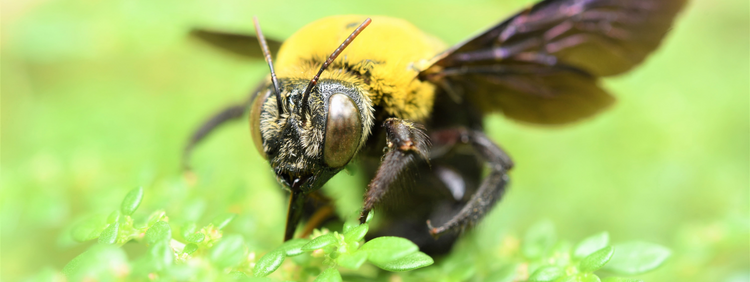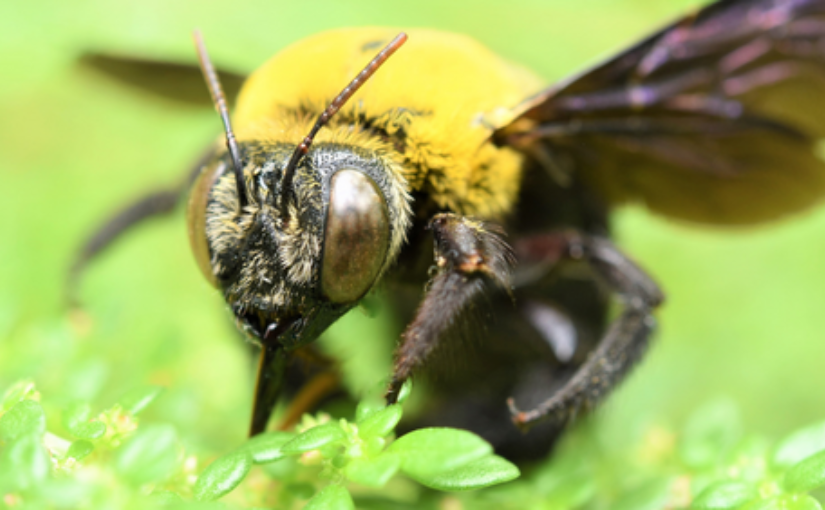
Carpenter bees are a solitary species, meaning that they either live alone or in pairs rather than in large colonies. Though they aren’t particularly aggressive, they can cause significant property damage when making nests. Therefore, they are frequently the reason behind calls for residential pest removal in Haldimand-Norfolk.
What Do Carpenter Bees Look Like?
Carpenter bees may be mistaken for bumblebees as both species are about the same size. However, there are some important differences. Bumblebees typically have fuzzy hair all over their bodies. A carpenter bee may have hair on its head and thorax, but the abdomen is typically smooth. Similarly, a bumblebee may have yellow on its abdomen along with black. Carpenter bees typically have all-black abdomens, though they may be iridescent with shades of blue, green, or purple.
Where Do Carpenter Bees Make Nests?
Carpenter bees make nests by boring into a wooden surface and excavating a tunnel underneath. Also called a gallery, each tunnel can accommodate up to six eggs. Carpenter bees create chambers for each of their eggs by installing a pollen plug after laying each. When the egg hatches, the pollen plugs provide food for the developing larvae. The larvae eat most, if not all, of the pollen before entering their pupal stage, allowing them to get out of the gallery when they emerge as adults.
Carpenter bees seem to prefer to make nests in bare, distressed hardwood. In the wild, that typically means making nests in fallen logs, which helps to promote decomposition. However, carpenter bees can also make nests in human homes by boring into decks, eaves, and fascia boards. Hardwoods may be their favourite, but they also seem to have an affinity for pine, and no species of wood seems to be completely safe from them. They have been known to make nests in stained wood.
What do Carpenter Bees eat?
Carpenter bees do not eat wood. They only hollow it out so they have a place to lay eggs. Carpenter bees are like most of their relatives in that they feed on pollen and nectar from plants.
Do Carpenter Bees Sting?
Female carpenter bees have stingers but they usually don’t sting unless provoked. The female carpenter bee is responsible for excavating the wood to build the nest, a position that makes her vulnerable to possible predators while working. While the female is working, the male keeps watch over the opening. If a potential predator approaches, the male acts very aggressively in an attempt to scare it away. This is all an act, however, as male carpenter bees do not have stingers and cannot do much more in defence of the nest than to act tough.
How Can You Prevent Carpenter Bees?
Carpenter bees are pollinators, which makes them very important to the environment and to agriculture. Therefore, it is preferable to prevent carpenter bees from making nests on your property if possible. There are several prevention steps you can take:
- Paint your wood. Carpenter bees use wood grain as a guide. If they can’t see the grain, they don’t know where to start excavating.
- Weather seal wood structures. Carpenter bees prefer distressed wood.
- Install outdoor speakers or hang heavy wind chimes. Soundwaves can produce vibrations in wood that disturbs the bees.
- Plant citrus-smelling plants around your home or treat wood with a citrus essential oil spray. Bees don’t like citrus smells.
- Use bee repellent to get them out of the holes and then seal up the holes so they can’t get back in.
Why Should You Choose Truly Nolen for Residential Pest Removal?
While carpenter bees aren’t directly harmful to humans, they can cause extensive property damage as they return to their nests year after year. Our methods of integrated pest management use the most environmentally friendly techniques available while still being effective. Find out more about the services we provide related to wasp control in Haldimand-Norfolk.
